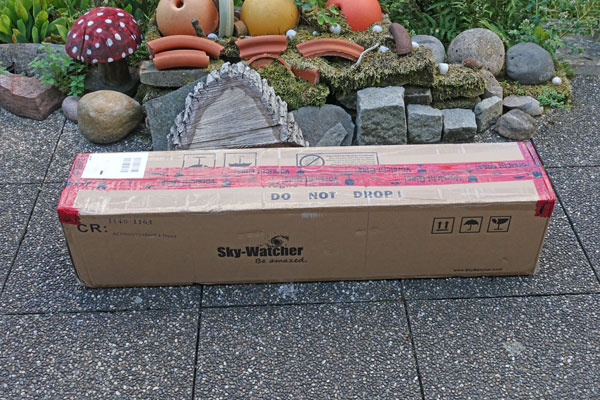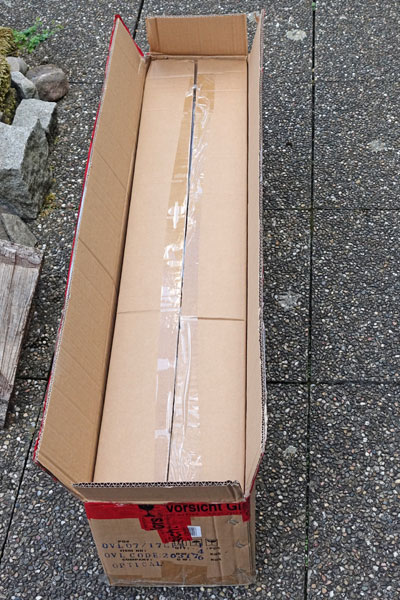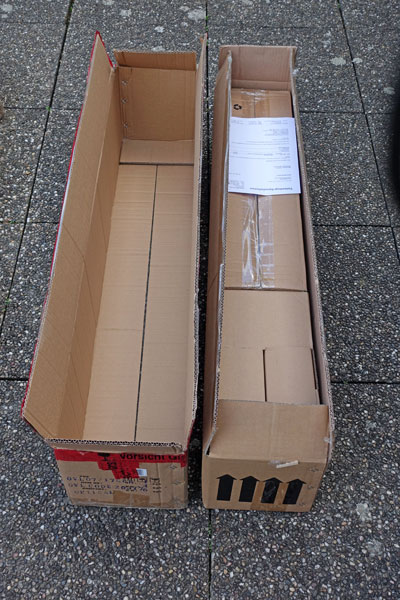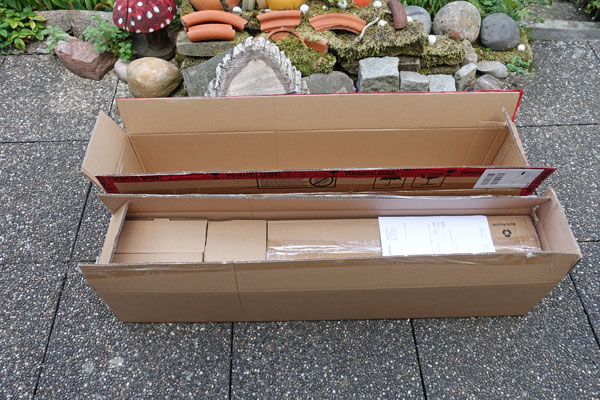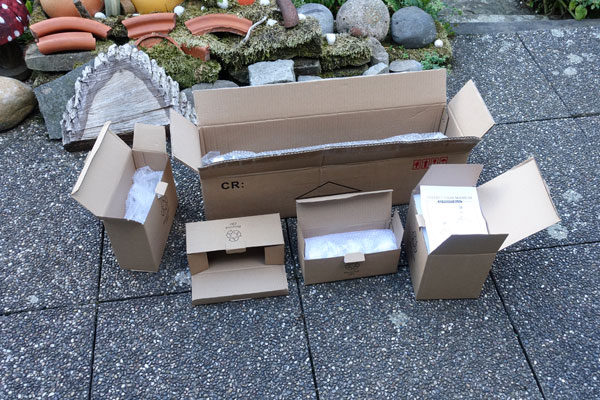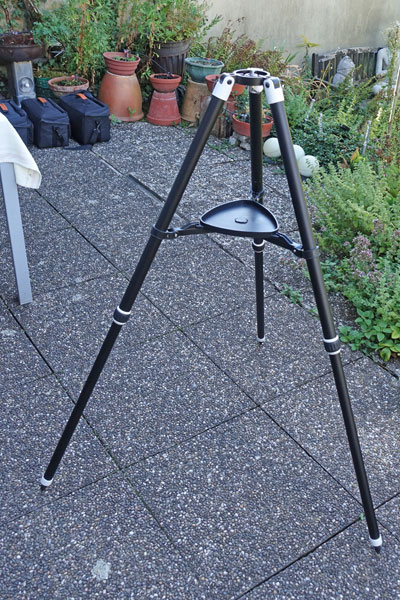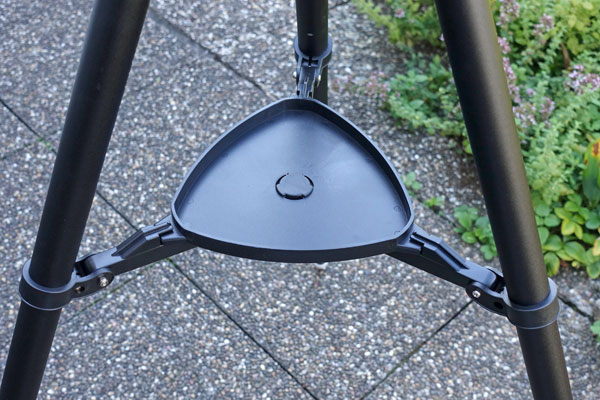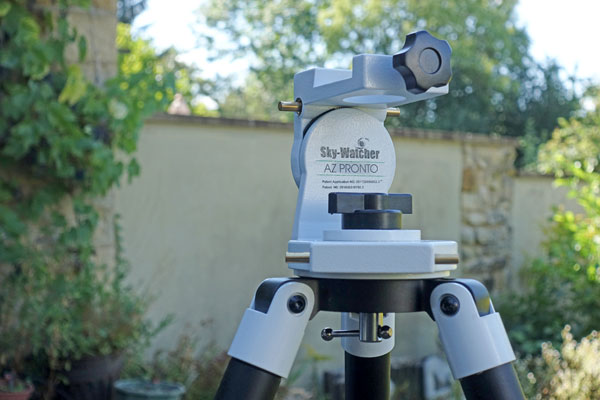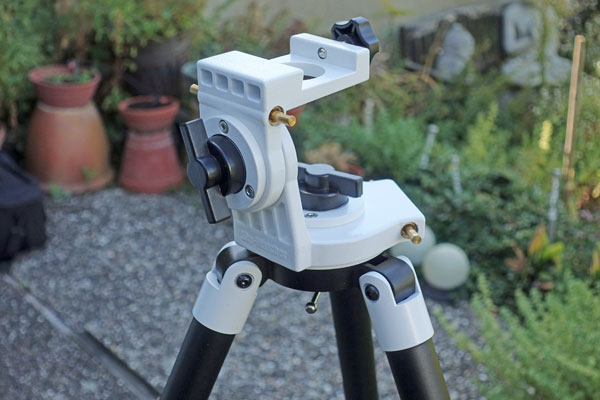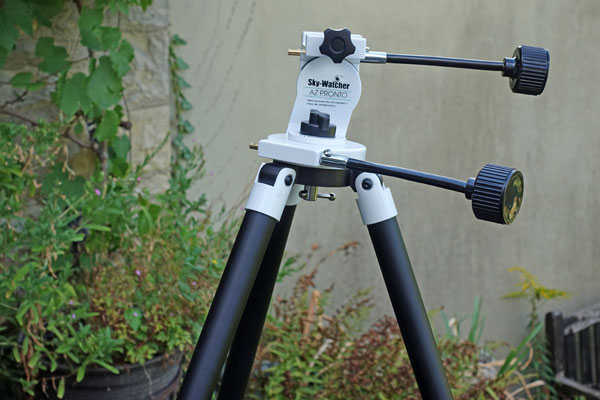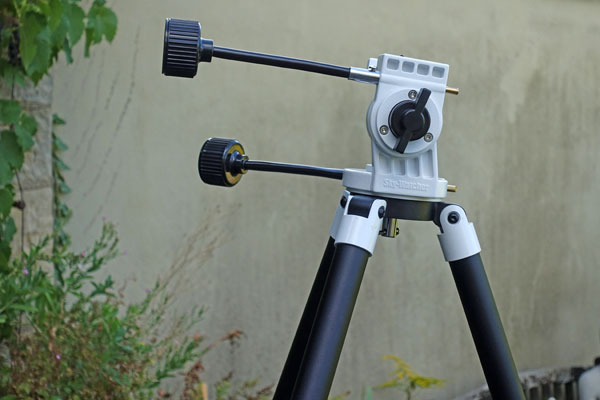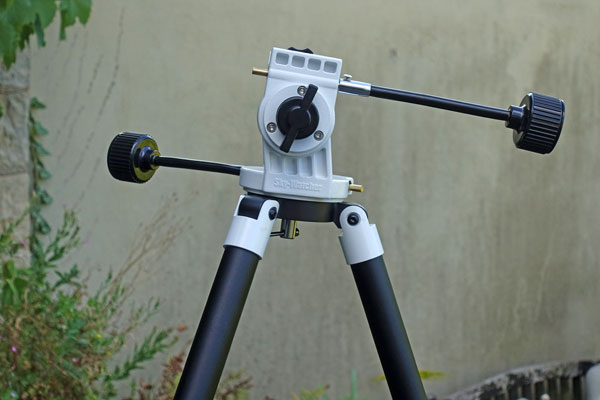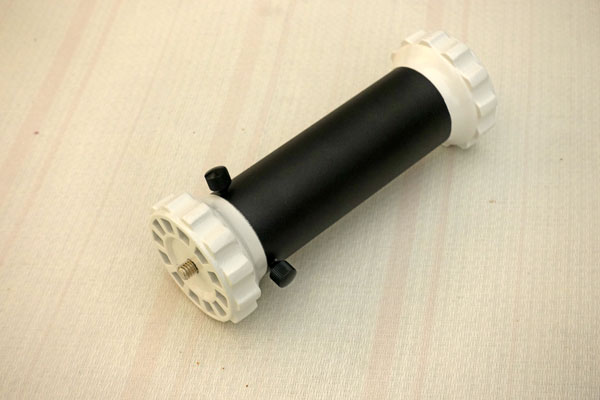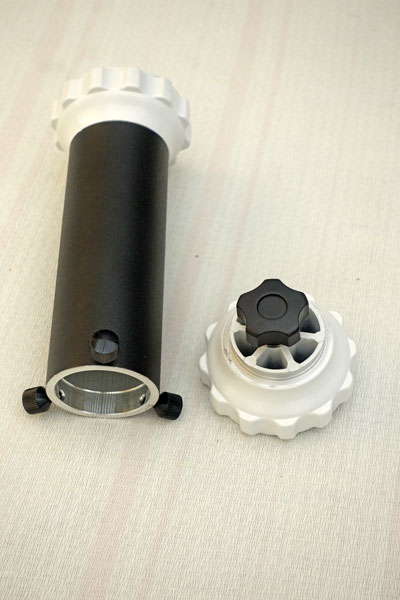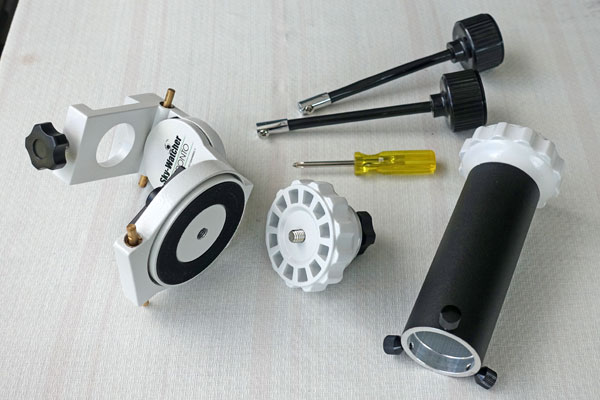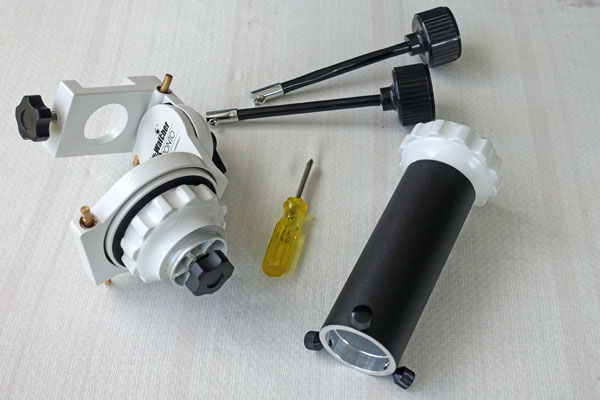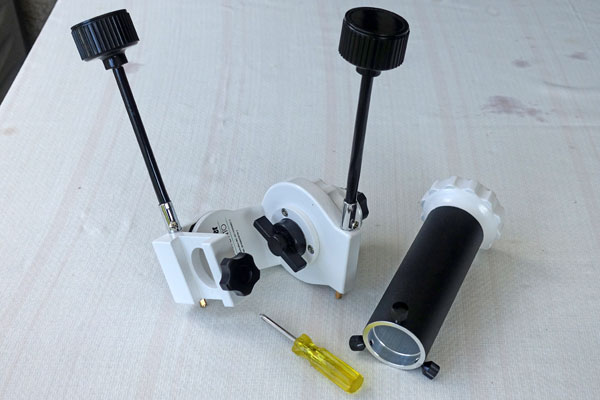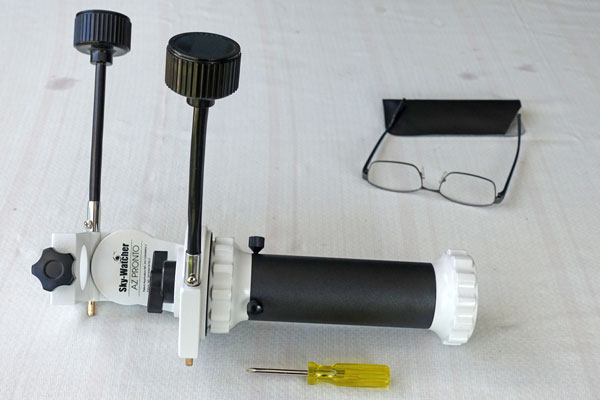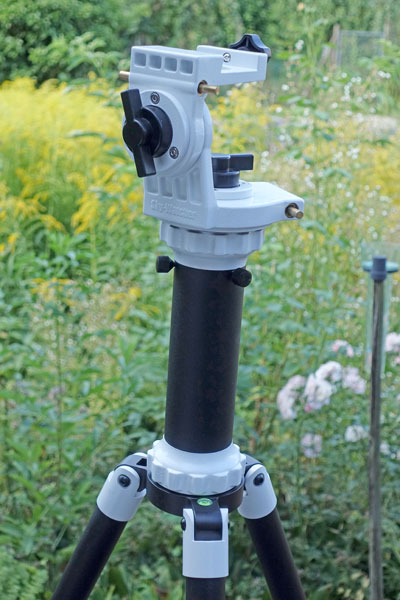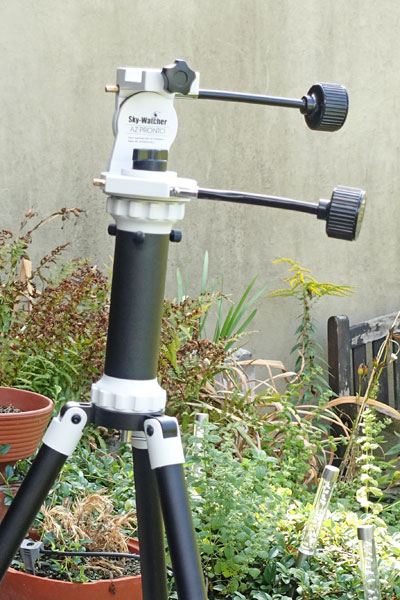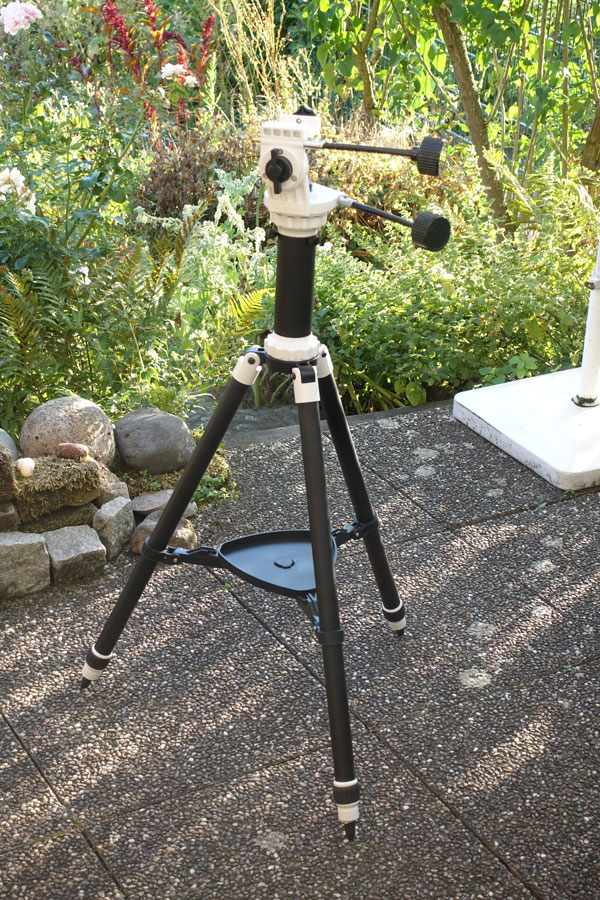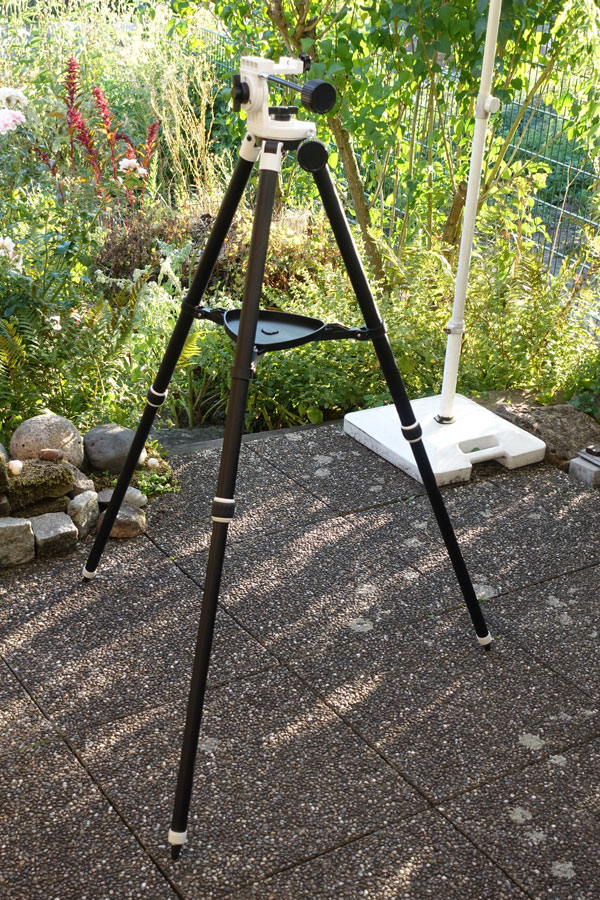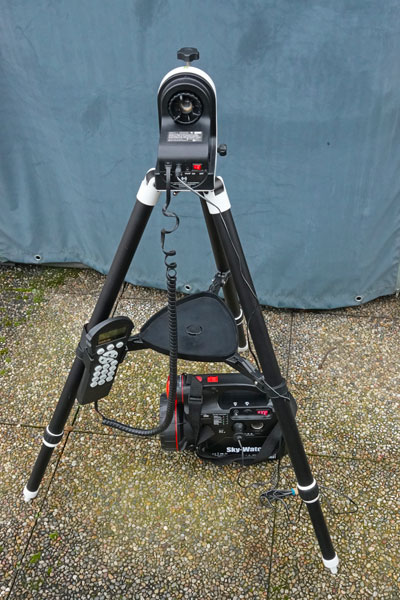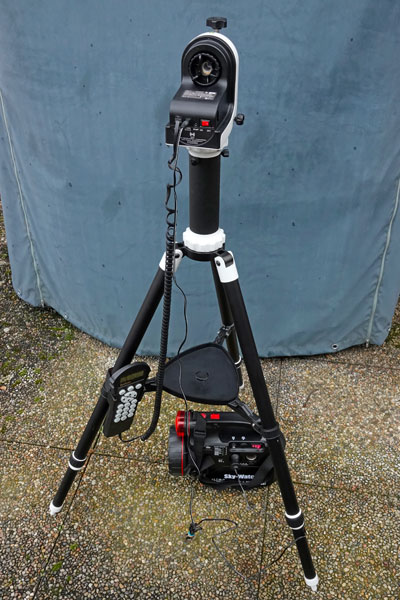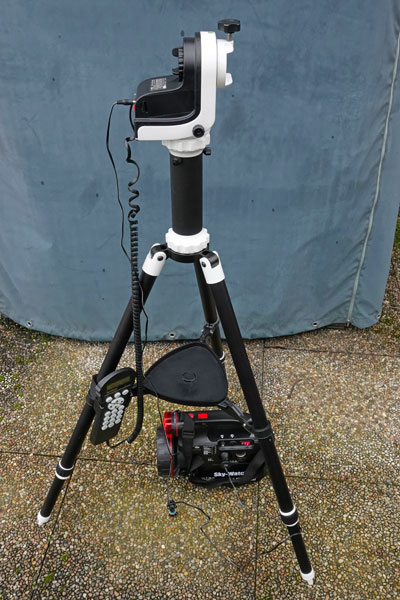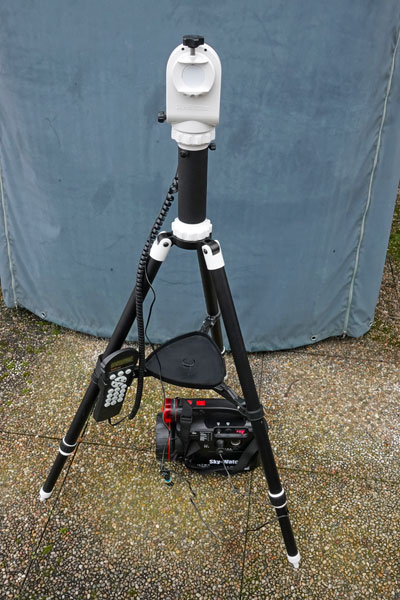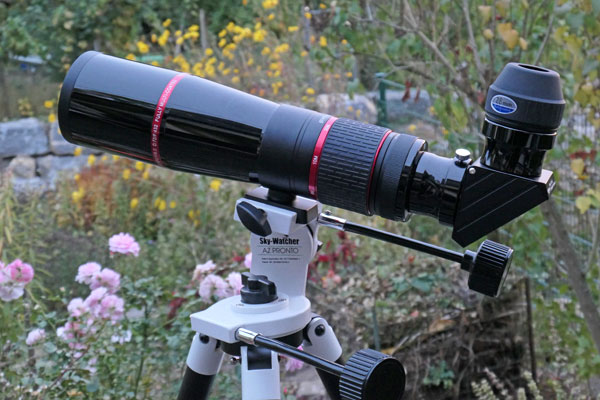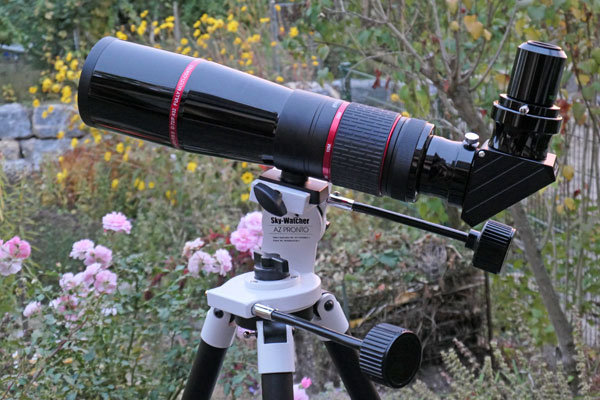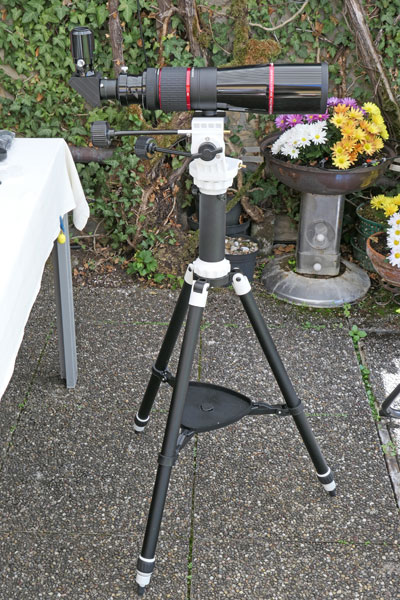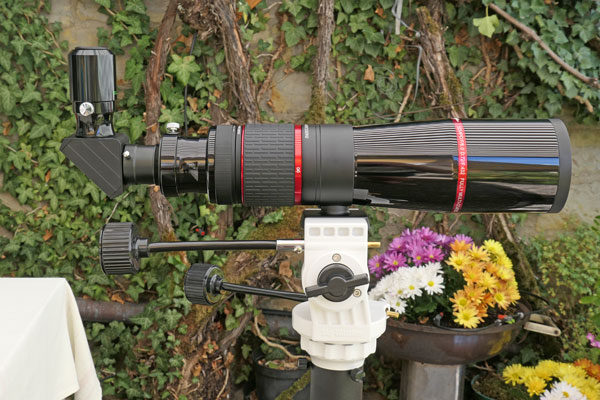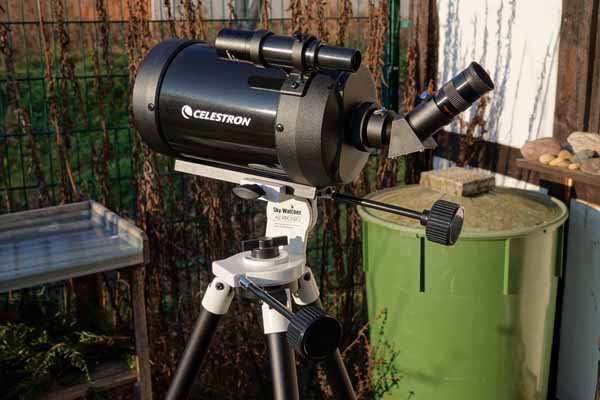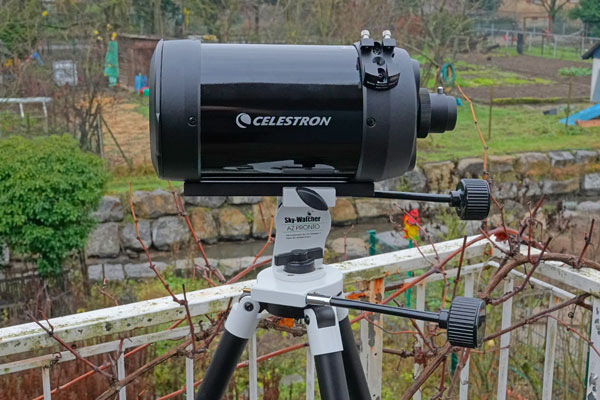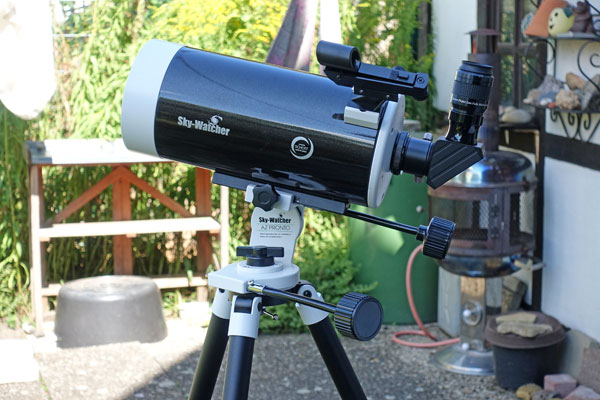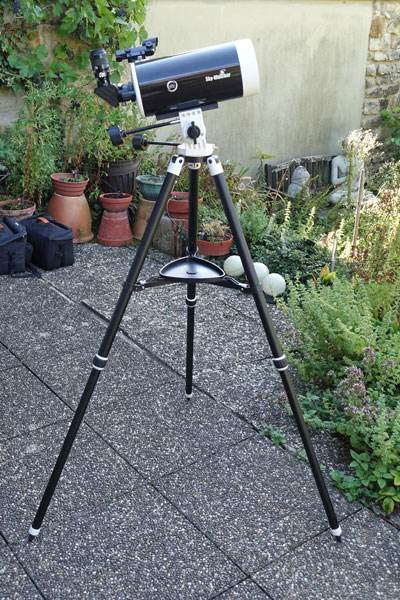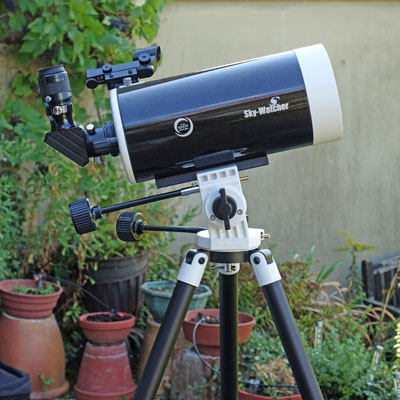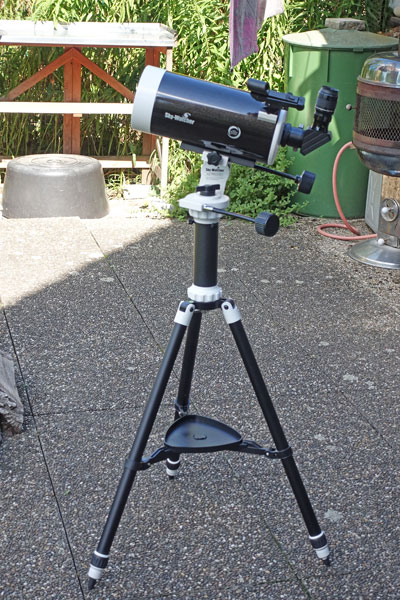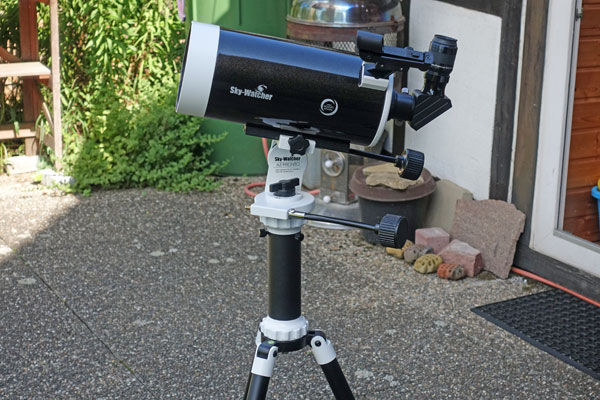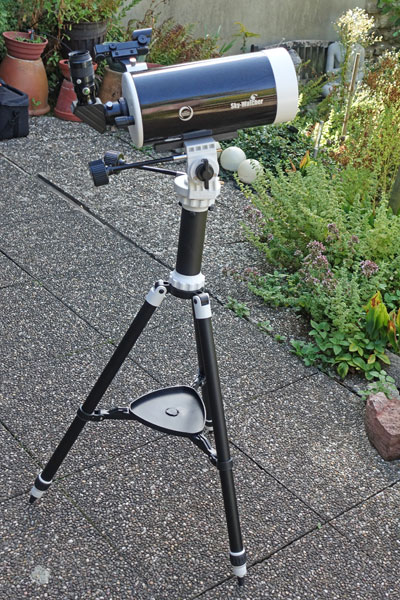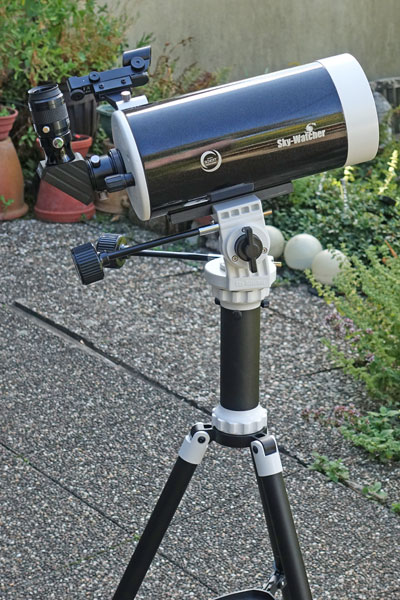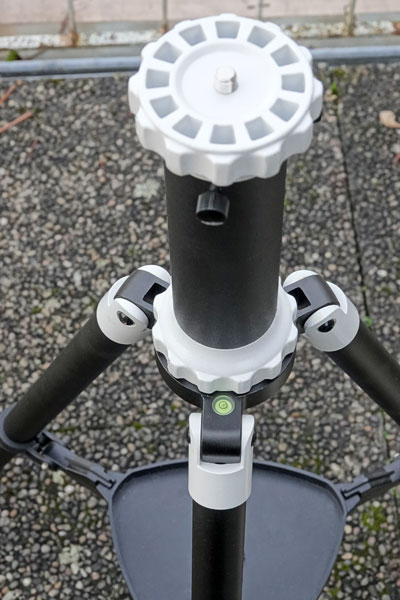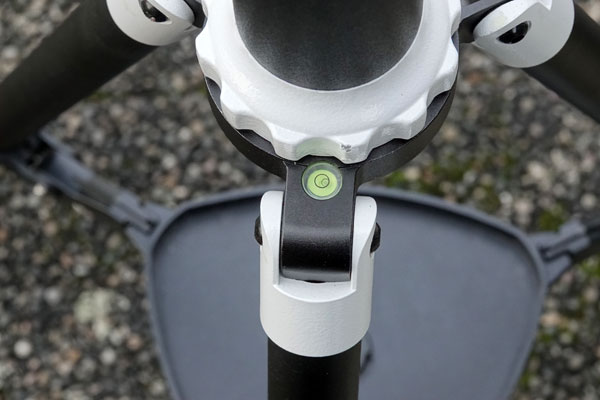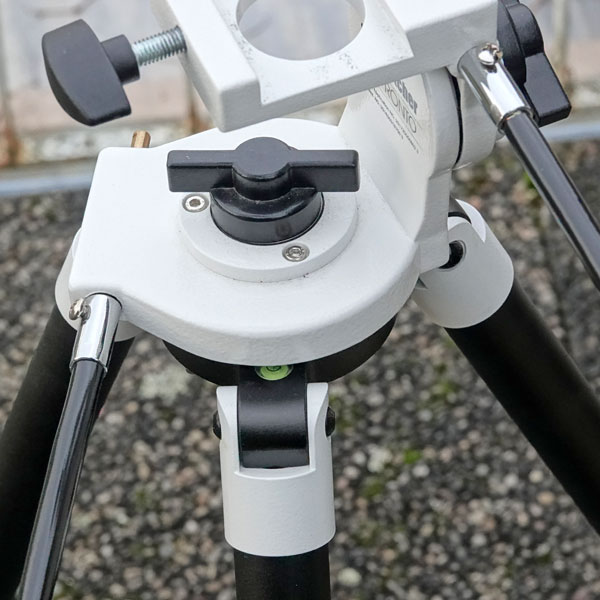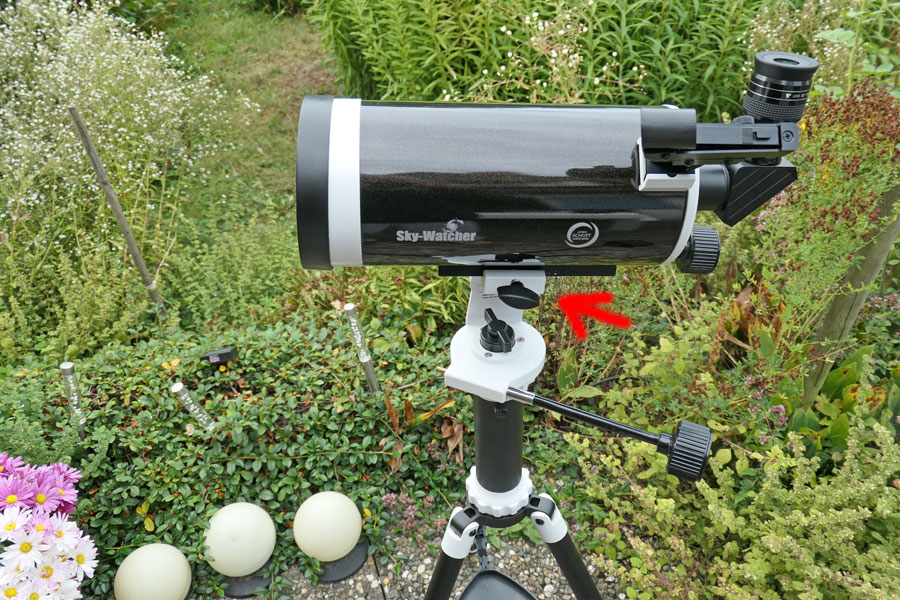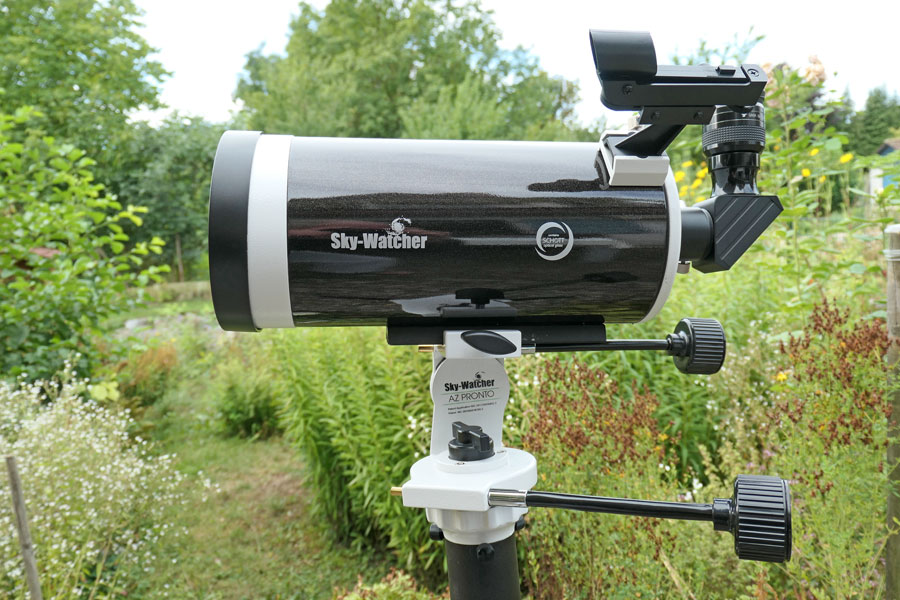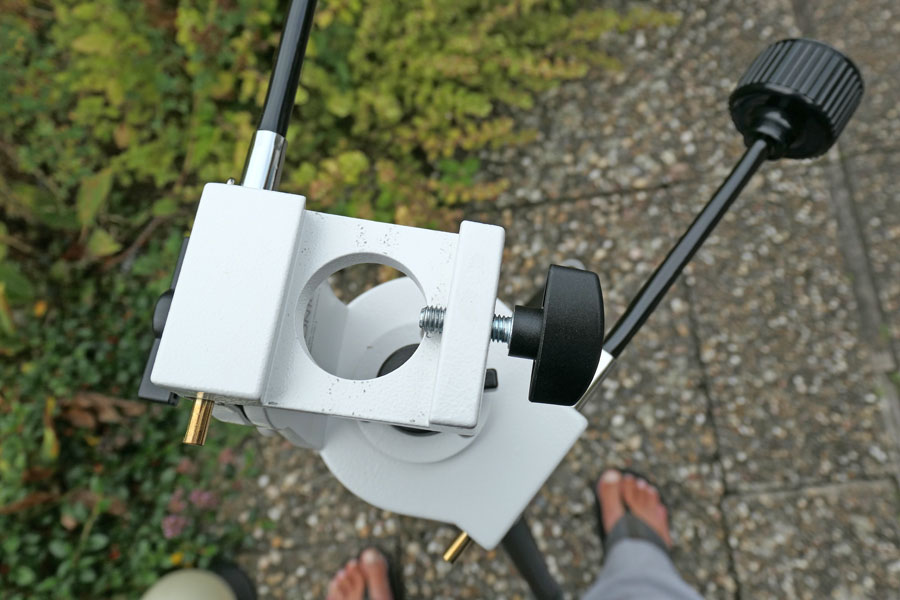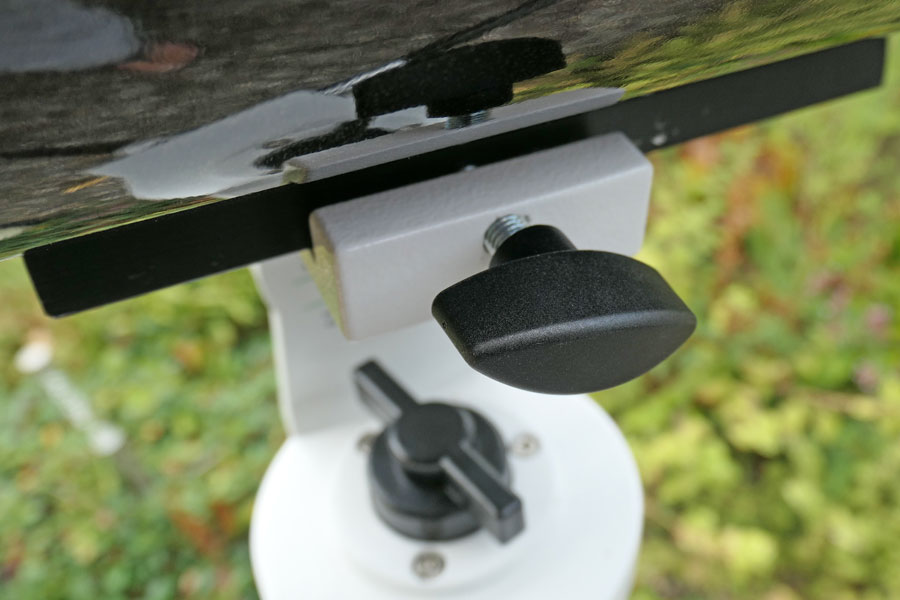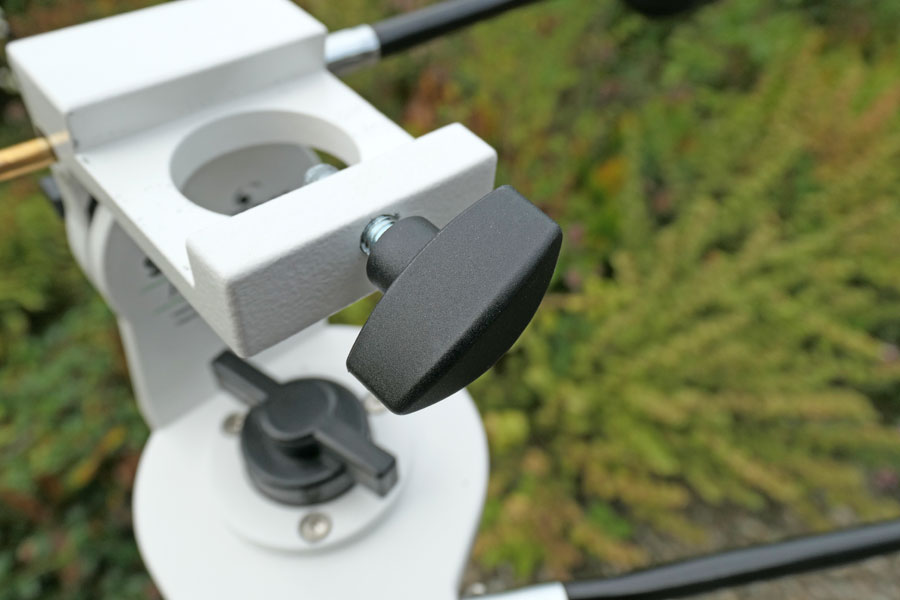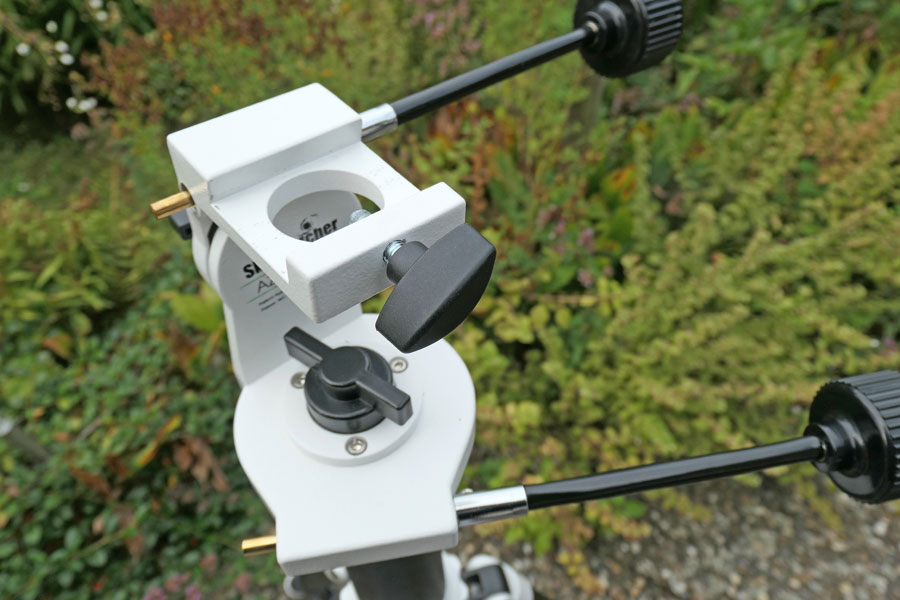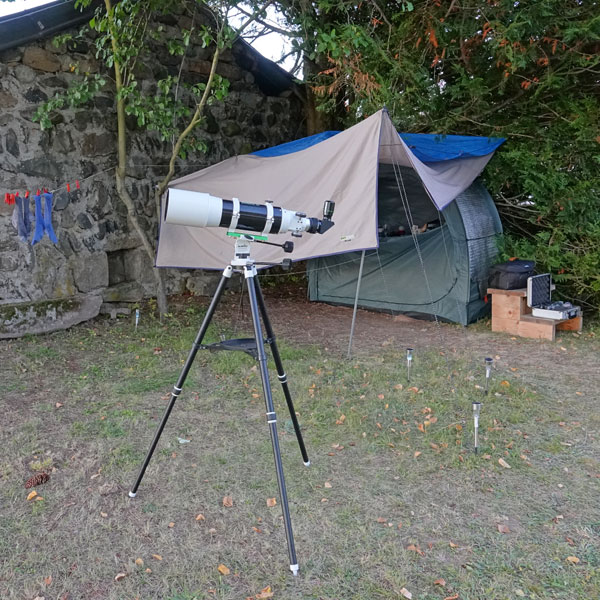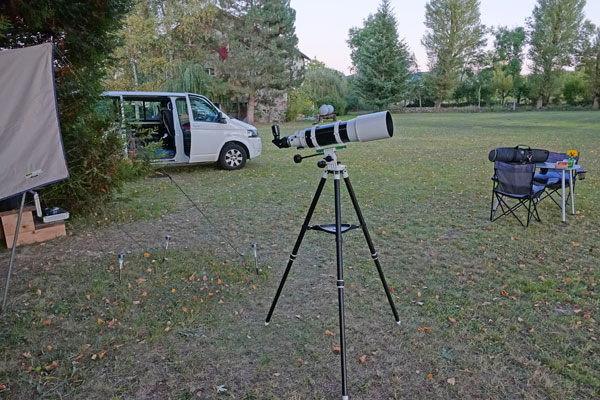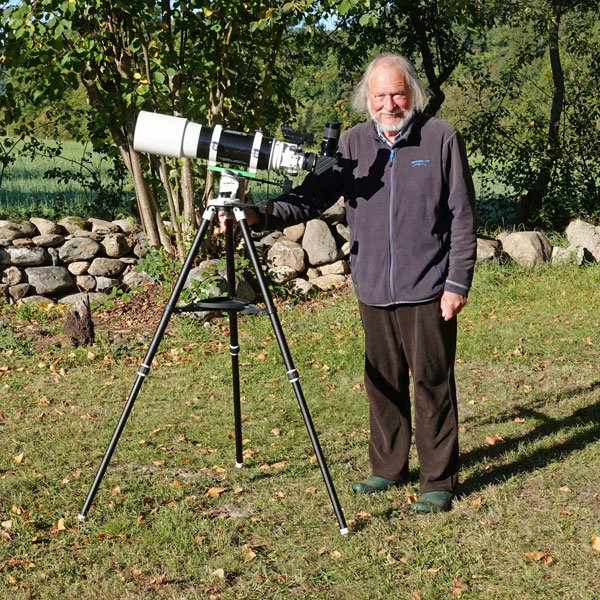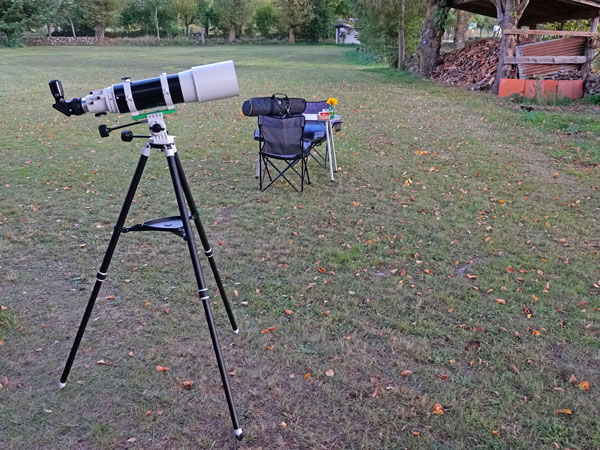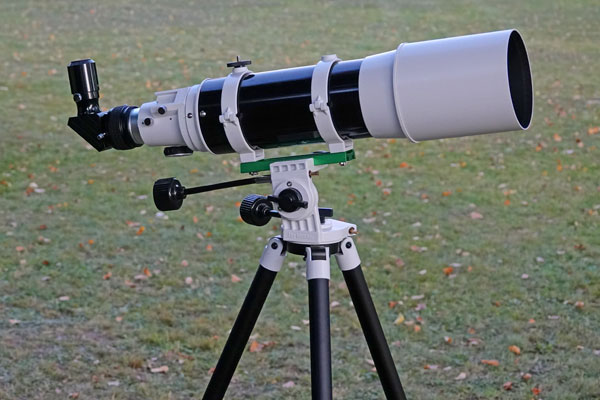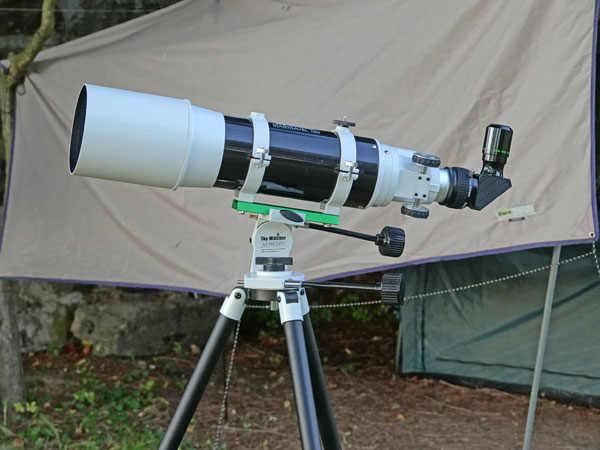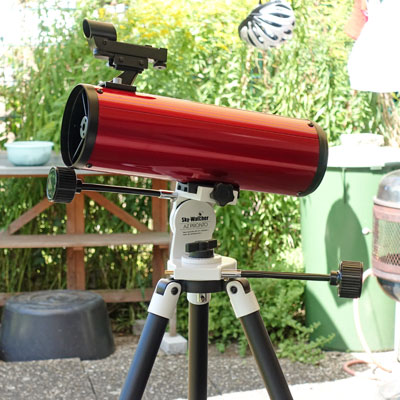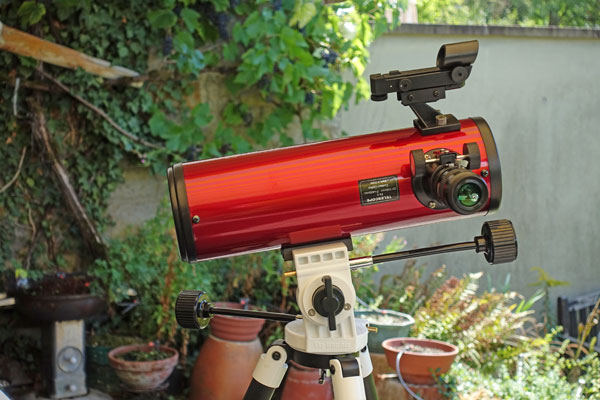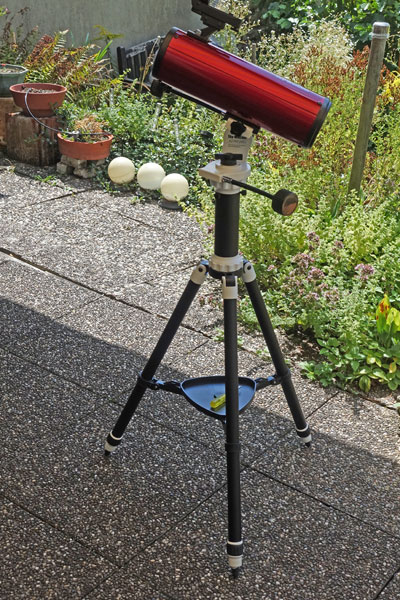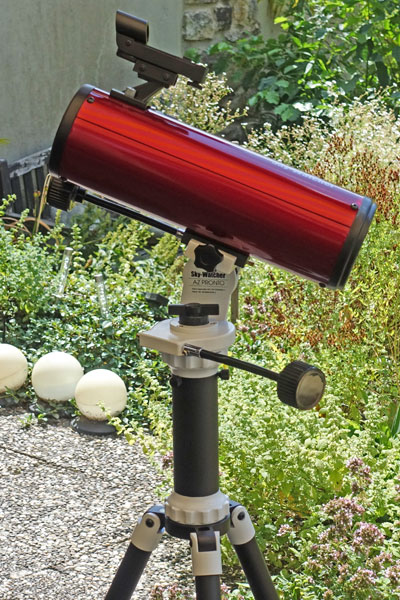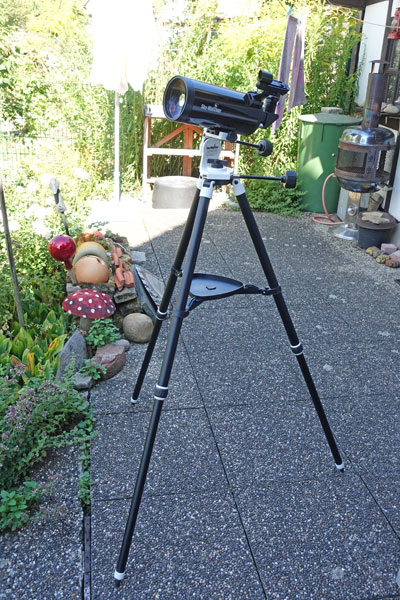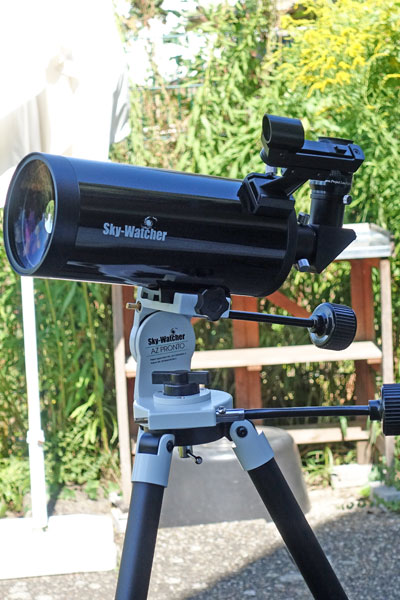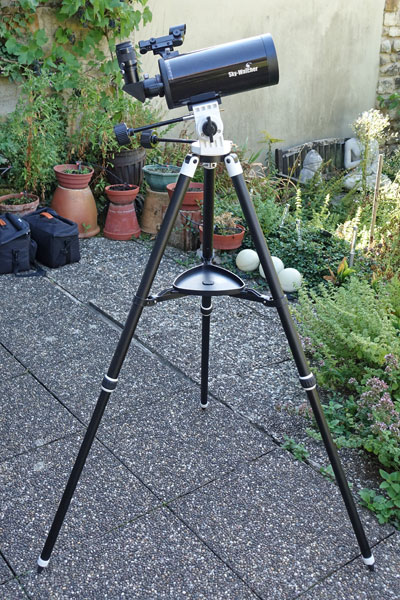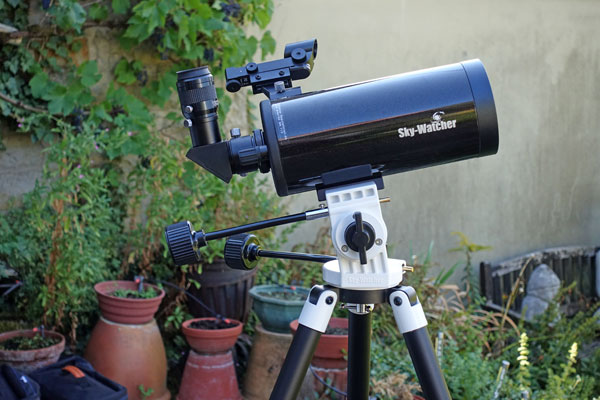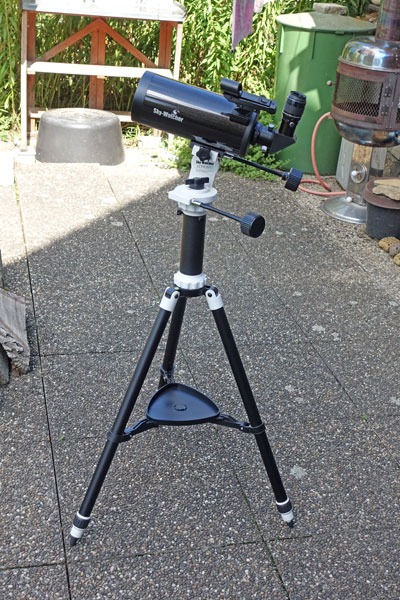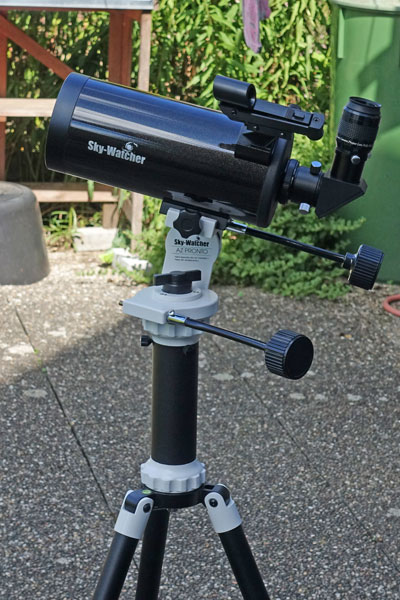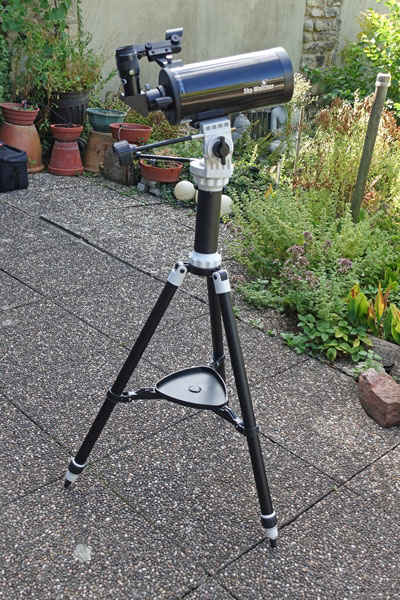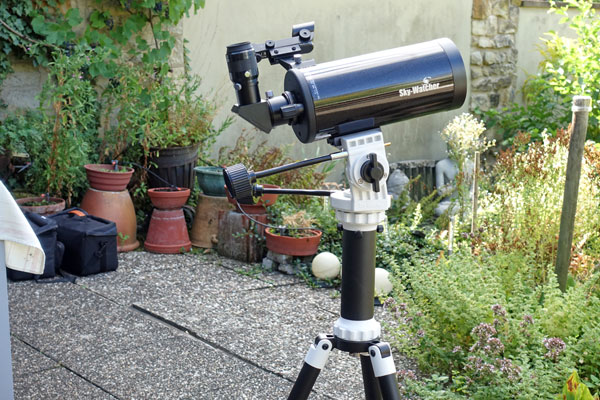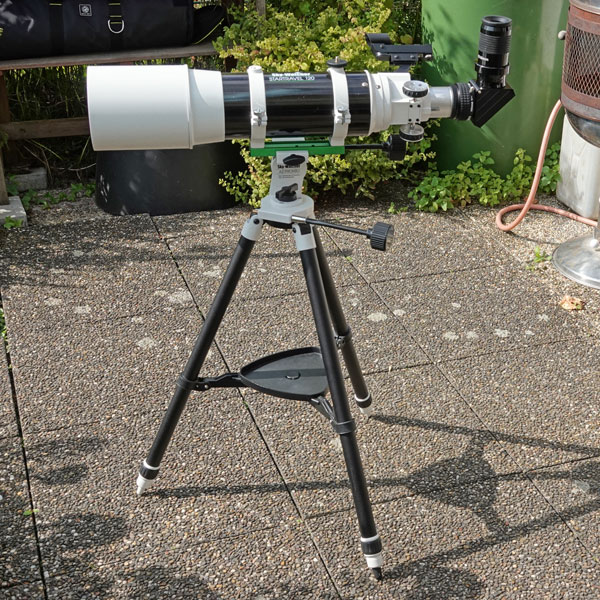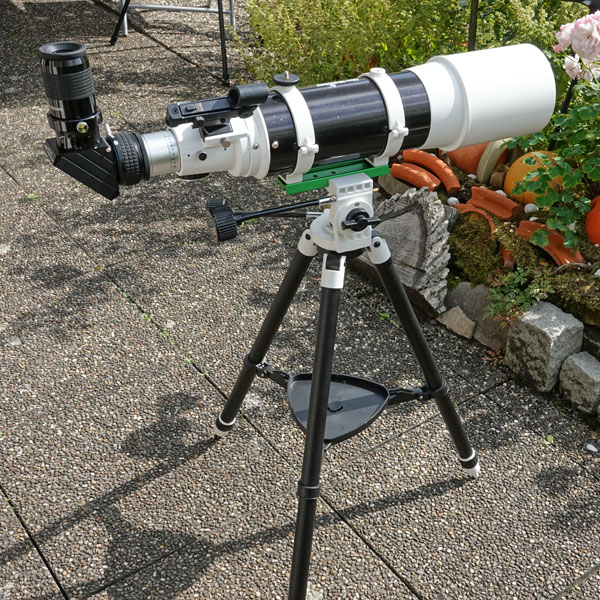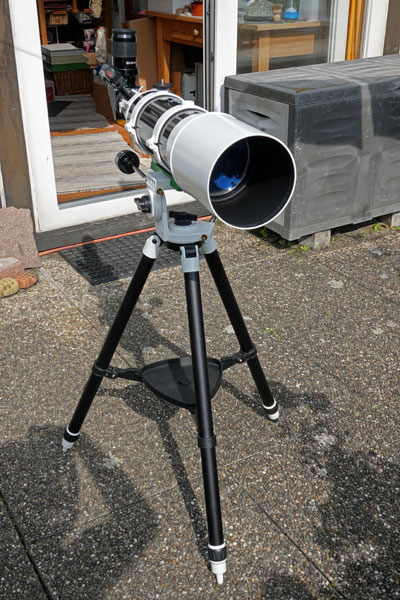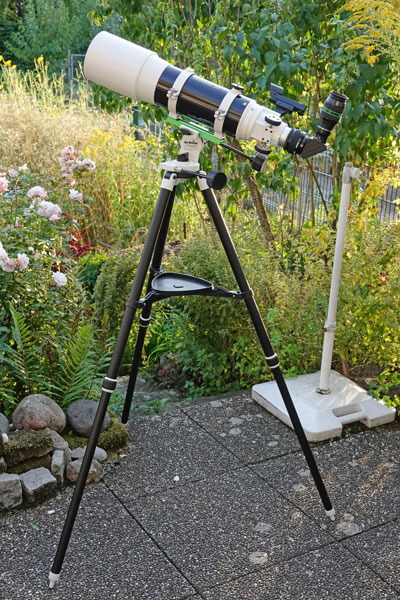Sky-Watcher AZ Pronto Mount Information
Motivation | Look | Look with Telescope Tubes | First Experiences | Conclusions | Links || Appendix: Data | Appendix 2: Sky-Watcher AZ Pronto Mount Report (for Teleskop-Spezialisten, Translated) | Appendix 3: Look with Previous Telescope Tubes
On this page, I present some information about my Sky-Watcher AZ Pronto telescope mount (ordered on August 6, 2018 , arrived on August 10). Originally, I intended to use the Sky-Watcher Heritage 100P telescope tube, the Skymax-102 OTA, and the Skymax-127 OTA on this azimuthal mount (see Appendix 3: Look with Previous Telescope Tubes), with the Skymax OTAs particularly for taking photos of the moon and planets. Meanwhile, I sold the Skymax-102 and Skymax-127, gave the Heritage 100P away, and added an Omegon PS 72/432 refractor as well as a Celestron C5 to my equipment (see further down for photos). Thus, my equipment has changed in the meantime, which is in part reflected on this page.
Note: In January 2021, I purchased a Sky-Watcher AZ-GTi mount head. Together with the tripod and the extension tube of the AZ Pronto mount, this becomes an AZ-GTi AZ GoTo mount. Or you can think of it as a "mount kit", where you can use either the manual mount head (AZ Pronto) or the GoTo mount head (AZ-GTi) on the AZ Pronto tripod (with or without extension tube; note that the mount head is also sold together with this tripod as AZ-GTi mount). More about the AZ-GTi mount head on page Sky-Watcher AZ-GTi AZ GoTo mount - Information.
See the appendix for the technical data.
Motivation
Why did I buy the Sky-Watcher AZ Pronto telescope mount and for what purpose? I bought it mainly to operate my two Sky-Watcher Maksutov OTAs, the Skymax-102 and the Skymax-127, fast, without needing electricity, and somewhat shake-free on a simple azimuthal mount. I considered using the Sky-Watcher Heritage 100P on the AZ Pronto as well, but it was also in "good hands" on its own Mini-Dobson base.
In the course of time, there was a certain change in my equipment pool, and the Heritage P130, on whose basis I wanted to operate my Maksutovs as well, has left my house. The only way out was using the Star Discovery mount or the base of the Heritage 100P. The first solution is too cumbersome with as well as without electricity, the second one is actually much too wobbly, especially with the much too heavy Skymax-127 tube, which is why I hardly used this tube after I had purchased it used for quite some time.
I finally wanted to change this, especially since I had noticed that my photo tripods, just like the Mini-Dobson base, have problems with locking the height axis. When I tighten the Mini-Dobson base screw at a certain vertical position, the height axis still continues to move slowly - and much too fast for observation or photography when higher magnifying eyepieces are used. With one of my tripods, the height axis even slips through and can no longer be locked if the telescope tube is positioned too steep.
So I took advice from my dealer. He suggested the Sky-Watcher AZ4 and AZ Pronto mounts as possible alternatives. The AZ4 mount can carry more weight (up to 8 kg), but because the prism rail is mounted laterally and the tubes cannot be mounted reversely, this leads to an unfavorable position of the viewfinder (I discussed this in detail elsewhere...). So this mount was not an option for me. Thus, only the AZ Pronto mount remained as a candidate, even though, having only a load capacity of up to 3 kg, it is already overloaded with the Skymax-127. Like the AZ3 mount, it has flexible shafts for convenient fine adjustment of both axes. The future will show whether the AZ Pronto is indeed overloaded with the Skymax-127, or whether this combination is "workable" (I have a similar problem with the Star Discovery mount with my Exporer 150PDS tube...).
Update 2019: In September 2018, I bought an Omegon Photography Scope 72/432 refractor, in summer 2018, I had already sold my Sky-Watcher Skymax 102, and in early 2019, I gave away the Heritage 100p. So, there was a change in my equipment, and since then I use the PS 72/432 and the Skymax-127 on this mount.
Update beginning of 2021: At the end of 2020, I bought a Celestron C5 tube, which has a weight below 3 kg alt least without accessories. A also sold my Skymax-127 at the end of January 2021. So, from then on, I use my PS 72/432 and C5 tubes on the AZ Pronto mount (or with the AZ GTi mount head as a "AZ-GTi GoTo mount).
Update end of 2021: At the end of 2021, I bought my Skymax-127 back. Since then, I use my PS 72/432, Skymax-127, and C5 tubes on the AZ Pronto mount (or with the AZ GTi mount head as a "AZ-GTi GoTo mount).
Update end of 2024: At the end of 2024, I sold my Skymax-127 again and bought a TLAPO804 refractor. Since then, I use my PS 72/432, TLapo804, and C5 tubes on the AZ Pronto mount (i also sold the AZ GTi mount head at the end of 2024).
Look
Unpacking
|
Outer package |
Ditto |
Ditto |
|
Ditto, opened |
Ditto |
Ditto Shipping weight: 6.0 kg
|
|
Inner boxes shown |
Inner boxes opened |
Ditto |
|
Package content... |
Mount Assembled Partly and as a Whole...
Without Extension Tube
|
Tripod with eyepiece holder |
Eyepiece holder, also called accessory tray... |
Mount without extension tube |
|
Ditto |
Ditto |
Mount with flexible shafts for Maksutov tubes |
|
Ditto, other side |
Mount with flexible shafts for Newtonian tubes |
Ditto, other side |
Extension Tube
|
Extension tube |
Ditto, from the other end |
Top part removed for attaching the mount head |
The three screws on top have to be loosened to remove the top element of the extension tube. This way, it is easier to screw the mount head to the extension tube. |
||
|
Mount head and removed upper part of the extension tube |
Mount head attached to upper part of the extension tube |
Mount head with flexible shafts (for Maksutov) and extension tube |
|
Mount head with flexible shafts (for Maksutov) attached to the extension tube |
|
With Extension Tube
|
Mount with extension tube |
Ditto |
Ditto with flexible shafts for Maksutov tubes |
Completely Assembled
|
Mount with extension tube (145,5 cm) |
Ditto, tripod collapsed (96,5 cm) |
Mount without extension tube (123 cm) |
The first version is too high for me, currently I prefer not to use the extension tube.
AZ Pronto Tripod with AZ-GTi Mount Head
AZ-GTi mount head on AZ Pronto tripod without extension tube |
||
|
AZ-GTi mount head on AZ Pronto tripod with extension tube |
||
Look with Telescope Tubes
Note: For the look with the AZ-GTi mount head see page Sky-Watcher AZ-GTi AZ GoTo mount - Information.
AZ Pronto Mount with PS 72/432 Refractor
Note: For the refractor tube both flexible shaft also point backwards!
Without Extension Tube
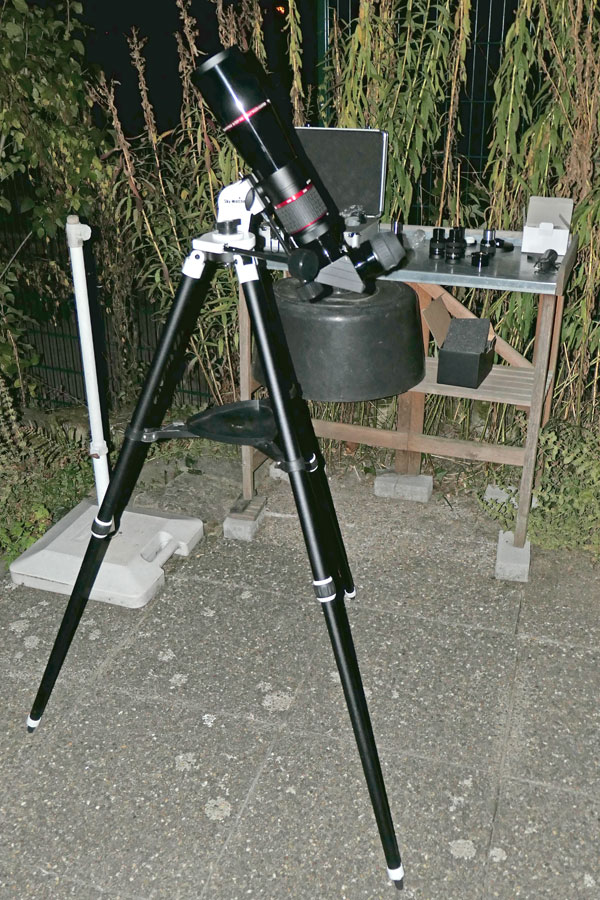 |
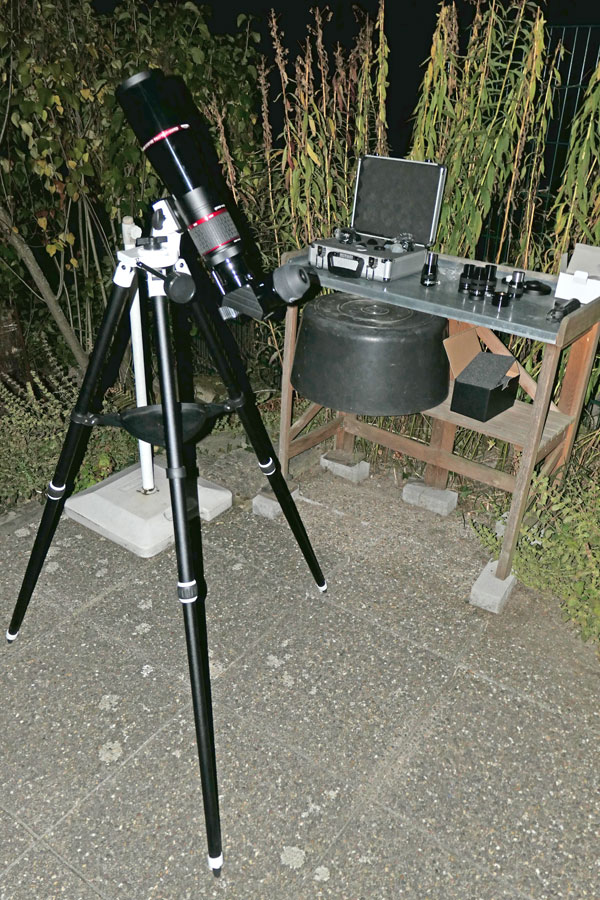 |
|
| PS 72/432 refractor with 2" zenith mirror and 2" as well as 1.25" eyepiece (and adapter; bottom left) | ||
With Extension Tube
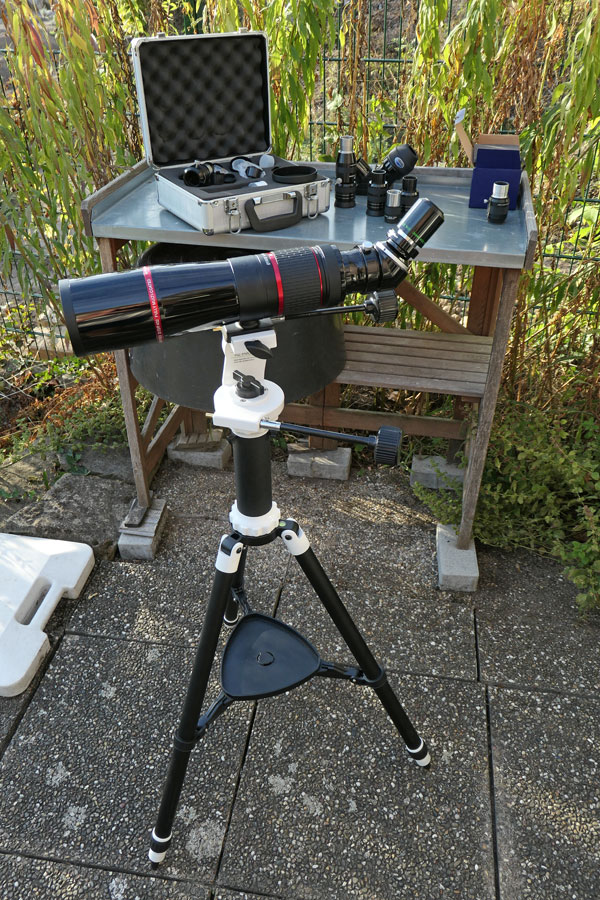 |
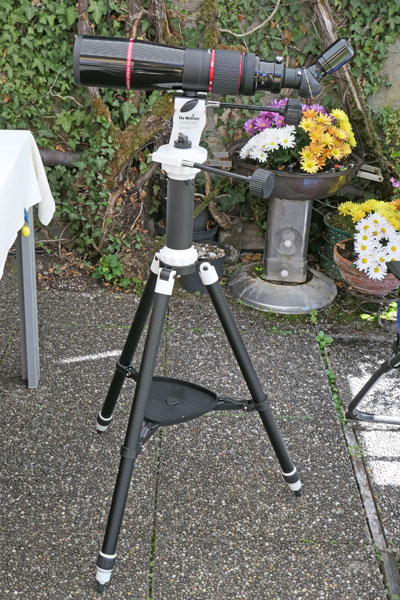 |
 |
PS 72/432 refractor with 2" to 1.25" Amici prism (left) as well as with mit 1.25" Amici prism (center, right) |
||
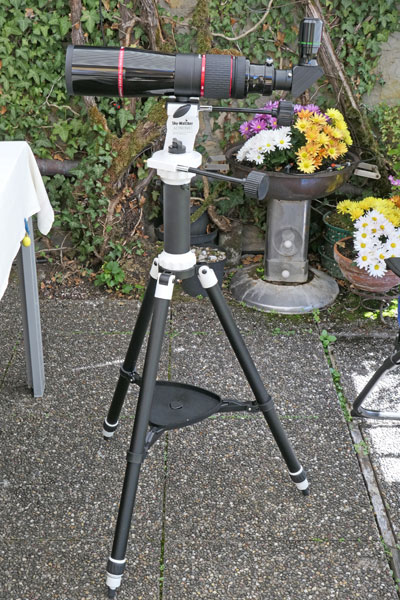 |
||
| PS 72/432 refractor with 1.25 " zenith mirror and 1.25" eyepiece | ||
AZ Pronto Mount with C5
There are only photos without the extension tube!
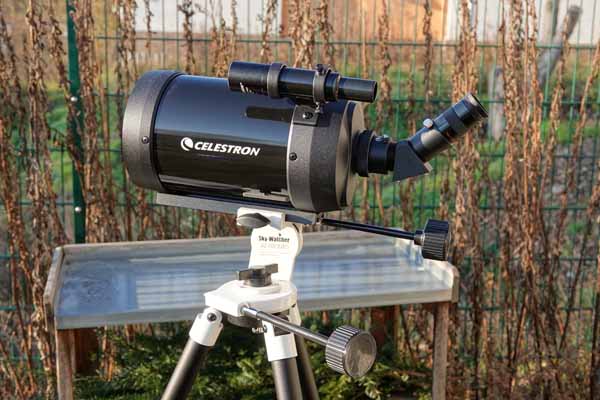 |
 |
|
AZ Pronto Mount with Skymax-127 OTA
Note: For the Skymax tubes both flexible shaft point backwards!
The Skymax-127 OTA weighs more than 3 kg and can therefore be used on the AZ Pronto mount only with caution. Here are some photos!
Without Extension Tube
Side view |
Ditto (detail) |
Other side |
Ditto (detail) |
With Extension Tube
Side view |
Ditto (detail) |
Other side |
Ditto (detail) |
First Experiences
You gain your first experiences, of course, when assembling the mount. As a left-handed person, I first mounted the flexible shafts on the wrong side. You have to take a closer look at the manual (or at product photos) to get it right...
My second "initial problem" was that the telescope tubes were moving back and forth horizontally, when I touched them, even though I had firmly tightened the locking screw. It turned out that the tubes' Vixen rails did not touch the bracket exactly, but were blocked by something. As soon as the rails were aligned with the bracket, everything was fine, and the wobbling was over. Obviously, when mounting telescope tubes to the AZ Pronto, I always have to make sure that the rail fits exactly!
Extension Tube, Tripod Height
The AZ Pronto mount is supplied with an extension tube, which weighs almost 830 g. My telescope dealer was not able to tell me whether the mount is better used with or without an extension tube. He wrote me that sometimes uses it this way and sometimes that way, depending on the height he needs. So, here are the advantages and disadvantages of both solutions from my point of view:
- Without extension tube:
- (+) Larger footprint because the tripod is extended further at the same height
- (+) Lower weight, fewer parts
- (-) Maximum height just under 1 m
- (-) Level is covered
- With extension tube:
- (+) Level is visible
- (+) Achieves heights up to almost 1.5 m
- (+) Tripod legs may not need to be pulled out (this may shake less...)
- (-) Smaller footprint, if desired (but more easily tipped over)
- (-) More parts potentially increases the wobble... (and do so in practice!)
- (-) Almost 1 kg more weight
Design-wise, I find it "sub-optimal" that the level for the horizontal alignment of the tripod can only be seen when the extender is mounted:
Top row: with extension tube Bottom row: no extension tube |
||
First I tried the mount without the extension tube, but it turned soon out that, depending on the telescope type (or viewfinder type and position), as well on as the vertical position of observed sky objects, one or the other way is better, as well as the question whether you should extend the tripod legs or not. Thus, I only can agree with my astro dealer - it depends. However, with extension tube, the telescope seems to tremble a bit more.
Newton: Viewfinder Position and Flexible Shafts...
When using my small Dobsonian = Newtonian telescope tube Heritage 100P, the viewfinder is exactly on the right side of the tube when using the AZ Pronto mount. That does not seem very practical to me, but I do not have any experiences with this so far...
I was also surprised that the manual advises to mount the flexible shafts in opposite directions for Newtonians. This kind of mounting is not explained in the manual, but when I take a closer look at my photos, I realize that one can then operate each of the shafts with the respective hand (refractors and Maksutovs have the view at the back, so both flexible shafts point backwards).
Usage, Slipping
The mounting can be moved roughly by hand and finely with two flexible shafts. I find the operation with the shafts very pleasant compared to the "messing around" with my Mini-Dobson bases. Using these bases, it annoys me a lot that the azimuth angle continues to slip even after tightening the locking screw, so that I often have great difficulty with adjusting the height axis correctly (such problems do not occur with "real" Dobsonian bases, though). This slipping (however, when using a photo tripod) while observing the total lunar eclipse 2018 annoyed me once again, and so I decided to acquire the AZ Pronto for operating my Maksutov tubes on it.
However, the vertical/azimuthal axis of the AZ Pronto mount cannot be adjusted as sensitively as the horizontal one. There are sudden jumps in the movement, especially when the tube stands steep and the weight probably presses on the vertical axis on one side. Maybe a better balance of the tube might help.
I have also noticed that the azimuthal adjustment can come loose when the telescope tube stands fairly steeps and is unbalanced. According to my telescope dealer, you have to tighten the clutches a little more in such cases (you should "dynamically" tighten them as needed, he wrote). A certain caution is nevertheless required, because if the tube all of a sudden and with momentum turns to a vertical position, the mount might fall over...
I already wrote that Sky-Watcher suggests a different mounting of the flexible shafts depending on the telescope type. In the meantime, I have come to the conclusion that depending on the telescope you should try out how you want to attach the shafts yourself.
Trembling...
As expected, the AZ Pronto mount trembles after touches or operations, but it stops trembling much faster than my Mini-Dobson bases. I hope that with the AZ Pronto I will eventually be able to take "untrembled" photos of the Jupiter moons - so far I have not succeeded in doing so. A first attempt in this direction (on the first day) unfortunately failed due to upcoming clouds...
However, there is one application where the trembling of the mount bothers me a lot, namely when I mount a camera to the 32 mm DigiScope eyepiece, set it to "infinity" (MF) and adjust the focus at the telescope while checking this on the camera with an enlarged viewfinder image (viewfinder or LCD screen). With every movement of the tube's focus adjustment knob, the mount and thus, the camera trembles so much that I do not see anything on the display and have to wait until the mount has stopped trembling. This makes focusing continuously more or less impossible, and focusing becomes a bit of a gamble...
When observing purely visually, the mount stops trembling fast enough for me so that it does not disturb me.
A First - Negative - Surprise
When I tried to tighten the locking screw on the Vixen rail on August 20, 2018 to attach the Skymax-102 tube to the AZ Pronto mount, the screw seemed to revolve. I was shocked, and my first thought was that the thread, either that of the locking screw or that of the bracket, was damaged. I tried to tighten the Skymax-102 tube to some extent, but was afraid that the tube might fall out of the bracket. I then even tried to attach the heavier Skymax 127 tube to the mount - with even greater rservations. I probably should not have tried that out...
After I had calmed down a bit and thought about this matter (supper was in between...), I had the idea that the locking screw, which consists of a metallic threaded part and a knurled wheel made of plastic, might revolve in itself, and not the thread. And fortunately this was indeed the case! I tried out a spare locking screw from a Mini-Dobson base and it worked perfectly. I was also able to turn the knurled wheel of the clamping screw when I held the thread in place or carefully clamped it in a vise. The next morning, I described the issue to my astronomy dealer. It was obviously the first time that he had heard of such an issue (as is so often when you have an issue...).
Somewhere on the Internet I had read in a test or a review of the AZ Pronto mount that the owner had soon replaced the locking screw with a wing screw, but unfortunately I was not able to find this note again. anyway, I was probably not the first one who had this issue...
On the AME2018 astronomy fair, I found a suitable wing screw and will use it for now:
|
The new wing screw |
Ditto |
Wing screw from above |
|
Wing screw, a closer look |
Ditto |
Ditto, a little more remote... |
Another Small Issue: the Rubber Caps at the Tips of the Tripod Legs
The Sky-Watcher AZ Pronto mount is equipped with three rubber caps that cover the tips of the tripod legs. These rubber caps got torn one after the other, did then no longer stick to the tip of the tripod legs, and got lost over time - or I threw them away because they no longer sticked to the tips.
Photo: Here you can see the black rubber caps at the tips of the of the mount's tripod legs. In the meantime they all have disappeared...
This is definitely a "botch solution"! Sky-Watcher also uses these caps on my Star Discovery mount, where the caps are still there, but already partly damaged.
The AZ Pronto Mount when Travelling...
Since I own the AZ Pronto mount, I do not use it at home, but it also accompanies me on journeys and longer stays in Germany. Due to it size and also the space requirements of telescope and accessories, these are however always journeys/stays, where we are "stationary" and thus, remain at one or several places for longer time. On a trip where we are at a different place on every evening, it would be necessary to store the atronomy equipment inside the car in which we want to sleep, and even a VW bus is too small for that.
Typically, I dismantle the mount while traveling, sometimes do without the extender, because we are observing while standing, and try to accommodate the tripod somehow in a "space-saving" manner . If it is possible, I may also leave the tripod assembled, so that I can start observing faster.
|
ST120 on AZ Pronto mount on vacation in France |
||
I only used the PS 72/432 and a borrowed StarTravel 120/600, i.e. two refractors, on the AZ-Pronto mount on vacation. The latter weighs 4 kg (plus accessories) and thus, weighs more than the AZ Pronto can carry. The ST120 has in fact the same weight as the Skymax-127, but its 2" accessories are heavier than the 1.25" accessories of the Skymax-127. Working with the ST120 on the AZ Pronto on vacation and afterwards at home was, however, not a problem for me! Actually, I had intended to take the Skymax-127 on holiday in autumn 2019, but then the ST120 came in between...
Conclusions
All in all, the Sky-Watcher AZ Pronto mount meets my expectations, and I do not want to miss it anymore. So far, I even use the new Omegon PS 72/432 refractor exclusively on this mount, and I am very satisfied with this combination. Of course, I will use it on the Star Discovery GoTo mount one day, but the AZ Pronto mount allows a much faster set up and makes the "starting threshold" much lower than for a mount that has to be aligned first. Granted, I was even faster with the Heritage 100P on its small Dobsonian base, but that is now history... With the PS 72/432 on this mount, I was even able to observe objects close to the zenith (e.g. M 39), although viewing through the eyepiece is in this case a bit tedious - despite the zenith mirror. But at least it is possible! The AZ Pronto mount also managed to carry my in the meantime sold Skymax-127, which was, according to the technical data, too heavy for it, but it seemed to work for me (except for the trembling...).
If there is something about the mount that bothers me, it is the trembling that can sometimes make focusing time-consuming at high magnifications. This is all the more true for photos of the moon taken using the projection method. The trembling makes this really difficult due to the delays of the camera's electronic viewfinders in low light.
Of course, there is always room for improvement, and I still have not properly understood the principle of slipping clutches. But first of all, this mount seems to have become my "workhorse" for my smaller telescopes - at home, and also when travelling.
In January 2021, I purchased a Sky-Watcher AZ-GTi mount head. Together with the tripod and the extension tube of the AZ Pronto mount, this becomes an AZ-GTi AZ GoTo mount. Or you can think of it as a "mount kit", where you can use either the manual mount head (AZ Pronto) or the GoTo mount head (AZ-GTi) on the AZ Pronto tripod (with or without extension tube; note that the mount head is also sold together with this tripod as AZ-GTi mount).
Links
- Sky-Watcher Company Website, USA: www.skywatcher.com
- Pages from German distributors for the Sky-Watcher AZ Pronto Mount:
- Teleskop-Spezialisten (here I bought the mount): www.teleskop-spezialisten.de/shop/Telescope-Mounts/Azimuthal-mount-ALT-AZ/Skywatcher-Mount-AZ-Pronto-with-tripod::3496.html?language=en
- Astroshop: www.astroshop.eu/alt-azimuth-without-goto/skywatcher-mount-az-pronto/p,55214#tab_bar_1_select
- Teleskop-Express: www.teleskop-express.de/shop/product_info.php/language/en/info/p10015_Skywatcher-AZ-Pronto---azimutale-Montierung-mit-Stativ.html
- See also my page offering Astronomy Links.
Appendix: Data for Sky-Watcher AZ Pronto Telescope Mount
Package Content
- Azimuthal AZ Pronto mount head
- Aluminum tripod
- 2 flexible shafts
- Extension tube
Data
- Shipping weight: 6.0 kg
- Shipping size: 117 x 25 x 23 cm
- Type: Azimuthal manual mount on tripod (Aluminum)
- Max. load visually: 3.00 kg
- Max. load photographic: 3.00 kg
- Mount weight total: 3.85 kg
Appendix 2: Sky-Watcher AZ Pronto Mount Report (for Teleskop-Spezialisten, Translated)
Introduction
I bought the Skywatcher AZ Pronto mount in August 2018 after consulting Mr. Kloß in order to be able to operate my Sky-Watcher Maksutov Skymax-127 OTA (briefly also my Skymax-102) as well as the Sky-Watcher Heritage 100P fast, without electricity, and somewhat shake-free on a simple AZ mount.
I decided against the AZ4 and for the AZ Pronto mount because of the horizontal mounting of the telescope, despite the fact that with a load capacity of up to 3 kg, it is already overloaded with the Skymax-127 (4 kg + accessories). Like the AZ3 mount, it has flexible shafts for convenient fine adjustment of both axes. So far, I have the impression that the AZ Pronto is hardly overstrained with the Skymax-127, and that this combination is "workable" (on the vertical axis, it sometimes runs a bit hoppy...).
In September 2018, I bought an Omegon Photography Scope 72/432 refractor, and in early 2019 I gave away my Sky-Watcher Heritage 100P. Since then I use the PS 72-432 refractor and the Skymax-127 on this mount.
First Experiences
I gained my first experiences when assembling the device. As a left-hander, I mounted the flexible shafts on the wrong side. You have to take a closer look in the manual (or on product photos) to do it correctly!
My second "initial problem" was that the telescopic tubes wobbled back and forth horizontally when I touched them, even though I had tightened the locking screw. It turned out that the Vixen rail of the tube was not exactly attached to the bracket, but had been blocked by something. As soon as the rail touched the holder, everything was fine and nothing wobbled anymore.
Extender
The AZ Pronto mount comes with an extender. Whether the mount is better used with or without an extender depends mainly on the height you need for observation, both standing and sitting. The extender makes the mount heavier (almost 830 g), and potentially increases tremble. And there is one more part to transport... Interestingly, the levelling bubble remains only visible when the extender is used.
Assembly of the Flexible Shafts for Newton
At first, I was surprised that, according to the manual, the flexible shafts have to be mounted in opposite directions at Newtonians, which have the eyepiece at the side in front. This kind of mounting is not justified in the manual, but if I take a closer look at my photos, I realize that then you can operate the two shafts with one hand each when observing from the side. Refractors and Maksutovs have the view at the back, in that case both flexible shafts habe to point to the back.
Operation, "Sliding"
The mount can be moved roughly by hand and finely with two flexible shafts vertically and horizontally. I find the operation with the waves very pleasant. However, the vertical/azimuthal axis of the AZ Pronto mount cannot be adjusted as sensitively as the horizontal axis. There are sometimes "jumps" in the movement, especially when the tube is steep and the weight probably presses on one side of the axis. Maybe a better balancing of the tube will help.
I have also noticed that the azimuthal setting can suddenly come loose when the telescope tube is relatively vertical and unbalanced. According to Mr. Kloß, you have to tighten the slipping clutches a little more in such cases. A certain caution is in my opinion nevertheless necessary, because if the tube suddenly and with swing vertically positions itself, the mount can also fall over already once...
Operation, "Slipping Through"
The AZ Pronto mount can be moved vertically and horizontally - coarsely by hand and finely with two flexible shafts. I find the operation using the shafts very pleasant. However, the vertical/azimuthal axis of the AZ Pronto mount cannot be adjusted as sensitively as the horizontal axis. There are sometimes "jumps" in the movement, especially when the tube is steep and the weight probably presses on one side of the axis. Maybe, a better balancing of the tube will help.
I have also noticed that the azimuthal clutch can suddenly come loose when the telescope tube is oriented relatively steeply and unbalanced. According to Mr. Kloß, you have to tighten the slipping clutches a little more in such cases. A certain caution is, in my opinion, nevertheless necessary, because if the tube suddenly and with momentum turns downwards, the mount can easily fall over...
Trembling...
As expected, the AZ Pronto mount trembles after touching or operating it, but it stops trembling much faster than my Mini-Dobson bases. When observing visually, the mount stops trembling after a few seconds, so I do not mind the trembling, except for at high magnifications.
There is, however, one application where the trembling of the mount is quite annoying, namely when I screw a camera for moon or planet photos to the eyepiece (projection method), set distance to "infinity" (MF), and adjust the sharpness on the telescope, while I control this with the camera at the magnified viewfinder image (viewfinder or LCD screen). With every movement of the focus knob on the tube, the mount and thus the camera tremble so much that I do not recognize anything on the display and have to wait until the mount has stopped trembling after a while. In addition, image in the electronic viewfinder is delayed in low light. Thus, a continuous focusing is practically not possible and the focusing becomes a bit of a gamble...
A First - Negative - Surprise: the Clamp Screw Goes Nuts
On August 20, 2018, when I wanted to tighten the clamp screw at the Vixen rail to fix my Skymax 102 tube to the AZ Pronto mount, the screw seemed to go through. I got a huge shock and my first thought was that the thread, either that of the clamp screw or that of the bracket, was damaged. By trying out other clamp screws, I was able to isolate the problem - it was the clamp screw. On the AME2018 fair, I found a suitable clamp screw and use this one from now on.
Another Small Negative Point: the Rubber Caps at the Tips of the Tripod Legs
The Sky-Watcher AZ Pronto mount comes with three rubber caps that cover the tips of the tripod legs. These rubber caps are torn one after the other on my tripod, have thereafter no longer held on to the tips of the legs, and have been lost over time. Or I threw them away because they no longer held at the tips.
Preliminary Conclusions
All in all, the Sky-Watcher AZ Pronto mount met my expectations, and I would not want to miss it anymore. It allows a much faster "get going" and makes the starting threshold much lower than that of a mount that needs to be aligned first.
With the PS 72/432 on this mount, I was even able to observe objects close to the zenith (e.g. M 39), even if the view is a bit tedious in this case despite the zenith mirror. But at least it could be done! The AZ Pronto mount also takes my Skymax-127, which is too heavy for it according to the technical data. But this combination works for me!
If something disturbs me about the mount, then it is the trembling that can sometimes make focusing a puzzle at high magnifications. This is all the more true for moon photos using the projection method. The trembling makes this really difficult, because there are also delays of the electronic camera viewfinders, when the light is low.
For the moment, this mount has become my "workhorse" for my smaller telescopes!
Appendix 3: Look with Previous Telescope Tubes
AZ Pronto Mount with Heritage 100P Telescope Tube
Note: For Newtonian telescopes the flexible shafts point to opposite directions! Also note that I do no longer own the Heritage 100P.
Without Extension Tube
Side view |
Ditto (detail) |
Other side |
Ditto (detail) |
With Extension Tube
Side view |
Ditto (detail) |
Other side |
Ditto (detail) |
AZ Pronto Mount with Skymax-102 OTA
Note: For the Skymax tubes both flexible shaft point backwards! Also note that I do no longer own the Skymax-102.
Without Extension Tube
Side view |
Ditto (detail) |
Other side |
Ditto (detail) |
With Extension Tube
Side view |
Ditto (detail) |
Other side |
Ditto (detail) |
AZ Pronto Mount with StarTravel 120/600 Refraktor (Borrowed)
Center: with 1.25" zenith mirror |
| 15.12.2024 |
